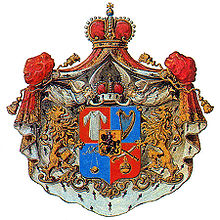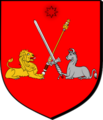Georgian Bagratids
The Georgian Bagratids ( Georgian ბაგრატიონი , bagrationi ) are a Georgian ruling dynasty . They were the longest-ruling royal family in the Caucasus . They started as a princely house and gained royal status in Georgia in the 9th century . In 1801 they were dethroned by the Russian tsar in Kartlien - Kakheti and in 1810 in Imereti , but still exist nominally as the royal house of Georgia to this day .
A possible common origin with the extinct Armenian Bagratids is controversial.
history
The origin of the Georgian Bagratid dynasty and the timing of its emergence in Georgia is disputed. According to Western scholars, the Georgian Bagratids are descended from Prince Vasak of the Armenian Bagratid dynasty, who fled to Iberia (now Eastern Georgia) in 722 . He was the son of the Armenian ruler Ashot III. His son Adarnase is said to have been given hereditary property in Klardscheti and Samtsche by the Georgian king . Adarnase's son Ashot I finally won the principality of Iberia and founded the last royal dynasty in Georgia.
The Georgian Bagratids created their own ancestry legend. They denied any connection with the Armenian Bagratids and derived from King David . They further claimed that Guaram I. Kuropalat (575-590) from the Chosroid dynasty was the first Georgian Bagratid ruler. Historiography has made this representation its own for centuries. Meanwhile, the biblical origin of the Georgian dynasty is no longer asserted. However, various Georgian scholars still maintain the view that Guaram was the founder of the Georgian dynasty.
The Georgian Bagratids ruled with interruptions, initially as Kuropalate , and from 809 as kings. Several rulers named Bagrat appear among the rulers of Abkhazia and Georgia . B. Bagrat III. on.
In Kartli-Kakheti (today Eastern Georgia) the Bagratids were dethroned by Russian Tsar Paul I in 1801 . Heir to the throne David Batonishvili was taken out of the country. His successors received the status of a prince in the Russian nobility . Russia's general Pyotr Ivanovich Bagration , who fought against Napoleon in the Wars of Liberation , came from this line. In Imeretia (today western Georgia) the Bagratids ruled until the conquest by Russia in 1810. The last ruler there was Solomon II (1789-1810).
Lines of the house
According to genealogical seniority, the oldest existing line of the Bagratids are the Bagration-Muchrani (or Mukhrani or Mukhraneli), a younger branch of the line of the kings of Kartlien, which ruled until 1724 (and expired in the early 20th century).
The genealogically younger line of the Bagration-Grusinski, however, ruled in the Kingdom of Kakheti and from 1762 to 1801 in personal union in the united kingdoms of Kakheti and Kartlien.
The Bagration-Imereti line ruled the Kingdom of Imereti until 1810, the last king of which Solomon II (1772-1815) only came to the throne after armed conflicts with rival relatives. He died childless, so that the claims to the throne fell to his cousin David (1781-1820), whose line expired in 1937. Descendants of an older, but illegitimate, brother of David, Simon, still exist in Georgia today, but are not recognized as legitimate by the other Bagratid lineages; the current head of the line is Irakli Davitis Dze Bagrationi (* 1982).
After the Red Army marched into Georgia in 1921, many members of the Bagratid family emigrated. While other descendants stayed in Georgia, in 1942 Irakli Bagration-Muchrani proclaimed himself head of the entire house in Rome and founded the Union of Georgian Traditionalists . Leonida Georgievna Bagration-Moukhransky (1914-2010) married in 1948 Vladimir Kirillowitsch Romanow (1917-1992), since 1938 head of the former Imperial House of Romanov-Holstein-Gottorp . Her daughter Marija Vladimirovna Romanowa (* 1953) is today's Russian pretender to the throne of the Romanov family.
The head of the Muchrani line is currently David Bagration-Muchrani ( Spanish: David Bagration de Mouchrani y de Zornoza ), who was born in Madrid in 1976 and now lives in Georgia. In 2003 he moved to Tbilisi and has had dual citizenship since then.
According to the prevailing opinion, however, Nugsar Bagration-Grusinski , director of the Tumanishvili Theater in Tbilisi, is the oldest patrilineal descendant of Kartlien-Kakhetien's last king, Giorgi XII. , since 1984 the head and the pretender to the throne of the Bagratids. The descendants of the Imeretic Bagratid line confirmed this claim in 2007.
Since the collapse of the Soviet Union and the restoration of Georgia's independence in 1991, the Georgian Orthodox Patriarch Ilia II has been pursuing the goal of restoring monarchy in all of Georgia under a Bagratid king in order to promote national unity. To this end, he arranged on February 8, 2009 the marriage of David Bagration-Muchrani with Anna Bagration-Grusinski, the eldest daughter of Nugsar Bagration-Grusinski. This marriage, although divorced again in 2013, unites the Grusinski and Muchrani branches of the Georgian Bagratid dynasty in the person of their son Giorgi (* Madrid September 27, 2011), who is considered to be the future pretender to the throne for Georgia and at the request of Patriarch growing up in the country.
See also
literature
- A. Gugushvili: The Chronological-Genealogical Table of the Kings of Georgia . In: Georgica. Vol. 1, No. 2/3, October 1936, ZDB -ID 425480-6 , pp. 109–153, ( digital version (PDF; 21 MB) ).
- David Marshall Lang : The Last Years of the Georgian Monarchy. 1658-1632. Columbia University Press, New York NY 1957.
- Oukase Impérial réglant le titre et le rang des princes Géorgiens domiciliés en Russie. In: Journal asiatique . Série 3, Tome 1, Fevrier 1836, pp. 205-207 .
- Cyrille Toumanoff : Manuel de généalogie et de chronologie pour l'histoire de la Caucasie Chrétienne (Arménie - Géorgie - Albanie). Edizioni Aquila, Rome 1976.
Web links
Individual evidence
- ↑ EurasiaNet: Time For a King in Georgia? ( Memento of the original from January 21, 2008 in the Internet Archive ) Info: The archive link was inserted automatically and has not yet been checked. Please check the original and archive link according to the instructions and then remove this notice. , October 12, 2007





